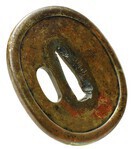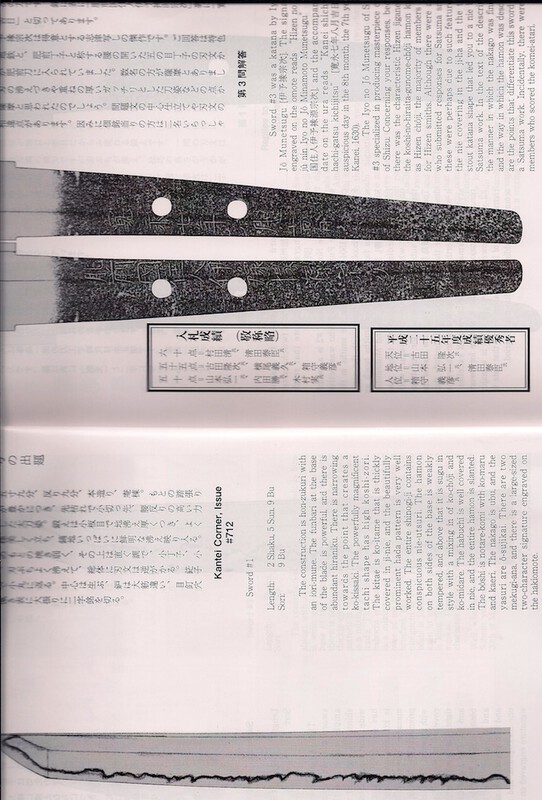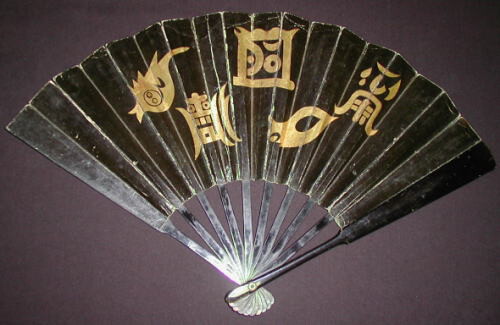-
Posts
2,441 -
Joined
-
Last visited
-
Days Won
21
Content Type
Profiles
Forums
Events
Store
Downloads
Gallery
Everything posted by Toryu2020
-

Translation request for characters on WWII Japanese holsters
Toryu2020 replied to lkgmadmax's topic in Translation Assistance
Circle with the character Dai 大 inside most likely Osaka arsenal mark Fwiw -t -
Grev - Do you have pictures of the signature itself? Might help to get to the correct answer. -t
-

Old collection of Nihonto Nakago
Toryu2020 replied to CurtisR's topic in Auctions and Online Sales or Sellers
This is the reprint however... -t -
Why isn't there a "LIKE" button on this forum? -t
-
John - Fred (Nihonto.com) only rarely visits these pages - after reviewing the articles in question I am convinced you have spotted a typo. A quick check of the Nihonto Meikan show that several generations of Yasutsugu and at least two Sadakuni received the title of Higo Daijo - while neither Yasutsugu or Sadakuni are listed as having the title Higo (no) Kami. This leads me to believe that Fred typed no Kami when he meant Daijo. Given the tremendous amount of research he has to do and the number of articles over the years this must be what happened. I can always ask him to clarify if it is a matter of great importance to the group... -t
-

Boxed Contemporary Iron War Fan translation needed
Toryu2020 replied to Ed Hicks's topic in Translation Assistance
A precious thing that. Take good care of it Ed. -t -
John - Make sure you search the archives here while you are at it - lots of nuggets buried among the many posts and pages. You might also check nihonto.com - the articles section there has good information on many of the well known smiths... -t
-
For my money the most useful reference is Nihonto Kenkyu to Kantei by Tsuneishi. This two volume book never ceases to amaze with geneologies, legends and histories, and work-style descriptions that make sense in the real world. The descriptions of the artists work often contain tidbits not found in other works and the author includes second and third generation artists not found or not extensively covered by other references. There are oshigata, photos, and mei included for comparison but the photography is of an earlier time and could use updating. If you are looking for a book with general appeal this will have something for everyone. I would also second Henk's call for a good reference on armour - seeing Trevors effort faulter was a real disappointment. Hoping we can see that come back to life or something like it. -t
-

Missing one character on nengo (Shigetsugu, pics added)
Toryu2020 replied to SwordGuyJoe's topic in Translation Assistance
Nice! and a terrific example of why one should be a collector of Kasama... -t -
Of course if working all this out in Japanese is too much for you - I can highly recommend the Shijo-kantei as published in the NTHK Journal Tô-ken to Rekishi. The explanations and answers are presented in Japanese and English. Translations by our own Dr Gordon Robson, in addition the lecture/explanations for the monthly kantei-kai and the occasional article are provided to the membership at no extra charge. This is a considerable amount of excellent information on swords delivered right to your mailbox in English - While the cost of dual membership is high, I find tremendous value in both. -t
-
Stephen asked, some time ago I know, how one might sign-up for the Shijo Kantei. Since the answer is a bit involved it took me a while to get around to typing this up; Fist off, please join the NBTHK - if in Japan through your local shibu, if in the US through the NBTHK/US or in Europe through the NBTHK branch for your home country. The cost of membership may seem dear at first but the benefits are worth it and the shijo kantei is a big part of that value. As a member you will receive the monthly magazine Tô-Ken Bijutsu. On the back-side of the monthly "centerfold" you will find the Shijo Kantei sword for that month. Shijo Kantei is roughly "Mail-in appraisal" - so this is a contest to determine the maker of a sword based solely on the description given and the oshigata presented in the magazine. The description is in Japanese, don't let that stop you, use your sword books and kanji flashcards to work your way through the description. It will be difficult at first but the real value in the practice is you will very quickly learn to read and speak "sword". Not only will you be able to translate this skill to the many other descriptions of swords in the magazine each month but I find it is useful when speaking to Germans, Frenchmen, Spaniards and even Japanese with whom I share no other common language but "Sword". There is a post card in the back of the magazine for you to use, you must provide the postage and you have to post your answer to the NBTHK so that it arrives no later than the 5th of the next month. the address is; Nihon Bijutsu Tô-Ken Hozon Kyokai (Shijo-kantei) Yoyogi 4.25.10 Shibuya-ku Tokyo-to Japan 151-0053 Your answer need only be the name of the smith, unless of course there are several generations in which case to get full points you need to include which generation. There is space for you to explain your reasoning, this may be left blank. If you do put something in, it helps the judges to provide a better experience for all in future contests. (note if you keep a journal of your answers you can track your own progress). The answer appears in the next months issue. A full explanation and the name of those who submitted correct (atari) or near miss (dozen) bids will appear in the issue two months later. I will attempt to add some photos to illustrate... -t
-

Missing one character on nengo (Shigetsugu, pics added)
Toryu2020 replied to SwordGuyJoe's topic in Translation Assistance
A rare date Joe - you really should share the rest of it if you have the chance... -t -

Translation and appraisal needed
Toryu2020 replied to hoobastank68's topic in Translation Assistance
John - Let me start by saying we have seen a lot more spent on a lot worse on this forum, so with very little knowledge, if I may say, you have done alright with your first purchases. If the responses here seem mixed it is because you ask a lot without seemingly heeded advice many times repeated on these pages. Imagine saying to your Iaido Sensei, I love your 300 year old art which you have spent decades mastering, "Can you teach me everything you know this weekend, I will send you a really big electronic thank you card if you do!" Since I am sure you are not that kind of student you'll understand if folks here think you should build a foundation first. Afterall Iaido is not just knowing how to draw but also when to draw. If you have a better grasp of the fundamentals you might find you are better equipped to make informed purchases. Ones that you will be happy with years from now. Also asking us to answer all of your questions is a bit like asking "Wheres the airport?" in a foreign language - you might get a long complicated answer you do not understand. For you to understand and learn from the answers given here it is best if you have a grasp of the lingo or at least references at hand that you can use to understand what is said. Hence "Books first, then swords!" Learn to describe your own swords using the accepted terminology - ask focused questions on the features you do not understand, I think you will be much more satisfied with the answers when your do. Take a look on line for the books of Markus Sesko - many of them are available as eBooks and will be good tools for your new hobby. You've taken a big first step, don't let the obstacles we've placed before you deter you, you have entered a world of study that is at least as much fun as drawing a sword... -t PS Sorry for all the Iai analogies couldn't help myself :D -
I might be looking at Kashu Kanewaka school - if I had to say this looks more like a yahazu-ba... -t
-
Grev - If you can see the five large "characters" in the image of the rubbing you are seeing it all. Basically they are representatives of the ancient form of the characters for North. South, East West that have been stylized to the point they look more like creatures. Since these characters represent the seat of the emperor this would have been a popular theme among those who studied Chinese classics or who espoused the cause of the Imperial house. -t
-
I would try a search for the following; The Five True Forms of the Five Sacred Mountains http://www.yijing.nl/i_ching/books/tai-shan.htm -t
-
Gabe - If the "Sword society" in your area is the one run by Harunaka Hoshino - run, do not walk, away from this deal. If your sword is worth anything now it will be worth nothing after his $700 polish. I may be biased but I suggest you attend a meeting of the Northern California Japanese Sword Club - our next meeting is tomorrow - see this link; http://www.ncjsc.org Anyone is welcome and you will receive fair, free and reliable advice as to next steps for your new sword. Bob btw is our newsletter editor... -t
-
Rich - I think I see the cloak of invisibility, the peach of eternal life, the lucky hammer of Daikoku and the key to eternal treasure house. if I didn't know better I'd say the theme here is "Treasure" FWIW -t
-
Junichi Look at Sasano Sukashi Sword Guards I believe he explains the state of ko-toehold and ko-katchushi quite well. -t
-
Axel - I think the only limit is size - if you want you can point us to a link, like a photobucket account then you dont have to upload all your photos one by one. The Hisayuki looks nice, count me as another hoping to see more... -t
-
-
Patrick - I have to say 655 was not that long ago - I guess I would not be surprised if I encountered one from 10 or more years ago. For you US Branch members out there this should be required reading! If you are not submitting for the Shijo Kantei you are not getting your money's worth... -t
-
城太郎光雄 Maybe?
-
I wonder did anyone else notice that this sword was a repeat? I only recently started seriously working these problems again and I am curious if this happens often? -t
-
I too am enjoying following this, I wonder have we jumped a step here - what about the basic construction of the piece itself - there was mention of the height of the design element - but what of the length, thickness and weight of the piece itself? What of the shape/size of the opening for the kogatana, what about how the piece is put together, one piece, two or three? Along with application/patination techniques is this not how we determine age? -t






